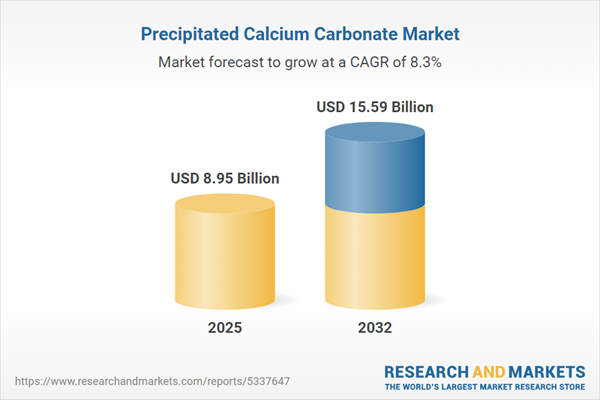Speak directly to the analyst to clarify any post sales queries you may have.
The precipitated calcium carbonate market is transforming as regulatory complexity and environmental priorities redefine operational imperatives. Senior decision-makers now prioritize strategic agility and digital modernization to sustain organizational resilience and long-term growth within this evolving sector.
Market Snapshot: Precipitated Calcium Carbonate Market
In 2024, the global precipitated calcium carbonate market is estimated at USD 8.26 billion. Forecasts project growth to USD 8.95 billion by 2025 and USD 15.59 billion by 2032, representing a compound annual growth rate of 8.27%. Expansion is driven by a rising demand for transparent sourcing, widespread adoption of sustainability initiatives, and increasing integration of digital processes across procurement and manufacturing. Investments are rising in automation solutions, as organizations adapt to evolving regulatory expectations and reinforce supplier relationships to ensure future readiness and compliance.
Scope & Segmentation
This report equips senior leaders with targeted analysis for guiding strategic choices within the precipitated calcium carbonate market. It outlines how organizations address compliance, implement new technologies, and uphold diverse standards for sustainable expansion and risk mitigation.
- Applications: Adhesives and sealants, food and beverages, healthcare, paints and coatings, paper, plastics, and rubber—each sector requires tailored compliance strategies and industry-specific performance standards, ensuring alignment with market and regulatory outcomes.
- End Uses: Agriculture, automotive, construction, packaging, personal care, and pharmaceuticals prioritize innovation in quality benchmarks, with ongoing improvements to match changing consumer and regulatory needs.
- Types: Both coated and uncoated precipitated calcium carbonate serve diverse requirements, ranging from improved durability to enhanced product appearance, enabling manufacturers to support a broad spectrum of customer demands.
- Purity Grades: Food, pharma, standard, and technical grades offer flexibility for producers operating under various industry guidelines and seeking multiple levels of third-party certification.
- Particle Sizes: Options from coarse through ultrafine enable fine-tuning of product opacity, brightness, and flow for specialized applications across key user segments.
- Regional Insights: The Americas, EMEA, and Asia-Pacific display varying regulatory and business environments, prompting leaders to develop region-specific entry and operating strategies for optimal market positioning.
- Company Analysis: Profiles on Omya AG, Imerys SA, Minerals Technologies Inc., J.M. Huber Corporation, Sibelco Group NV, Carmeuse Group, Mississippi Lime Company, Nordkalk Corporation, Shiraishi Calcium Kaisha, Ltd., and GHCL Limited provide insight into distinct technology initiatives and strategic moves within the market.
Key Takeaways: Strategic Insights for Leaders
- Operational oversight remains a critical focus as regulatory change and supply chain complexity grow, demanding active management for ongoing compliance.
- Digitalization within manufacturing and sourcing—including advanced micronization and surface modification technologies—expands access to regulated segments such as healthcare and packaging.
- Localization of sourcing strategies enables resilience, supporting rapid responses to supply chain disruptions and new compliance requirements.
- Supplier management is increasingly important, with forward-looking leaders investing in strong partnerships to achieve both quality targets and sustainability benchmarks.
- Integrated supply chain operations facilitate agile adjustments to shifting industry standards and support continuous process improvement across applications.
Tariff Impact
New US tariffs set for 2025 will alter cost structures in the domestic precipitated calcium carbonate landscape. In response, organizations are enhancing procurement approaches, reinforcing local supply networks, and focusing on tighter supplier collaboration. Evaluations of alternative supply sources help ensure operational continuity while supporting adherence to shifting trade and regulatory policies.
Methodology & Data Sources
This report is based on primary interviews with industry executives, thorough examination of corporate statements, relevant government disclosures, and proprietary research datasets. This multi-source approach ensures that recommendations are actionable and grounded in reliable evidence for senior decision-makers.
Why This Report Matters
- Equips decision-makers to identify and respond to regulatory and operational changes affecting the precipitated calcium carbonate market.
- Provides actionable market knowledge to refine procurement strategies and compliance practices at both regional and segment levels.
- Supports robust supply chain planning and organizational resilience as supplier dynamics and global market conditions shift.
Conclusion
Executives who prioritize strategic flexibility and segment-driven agility are poised to navigate the evolving precipitated calcium carbonate market. Proactive adaptation remains key to fostering resilience and sustaining growth as sector requirements change.
Additional Product Information:
- Purchase of this report includes 1 year online access with quarterly updates.
- This report can be updated on request. Please contact our Customer Experience team using the Ask a Question widget on our website.
Table of Contents
3. Executive Summary
4. Market Overview
7. Cumulative Impact of Artificial Intelligence 2025
Companies Mentioned
The companies profiled in this Precipitated Calcium Carbonate market report include:- Omya AG
- Imerys SA
- Minerals Technologies Inc.
- J.M. Huber Corporation
- Sibelco Group NV
- Carmeuse Group
- Mississippi Lime Company
- Nordkalk Corporation
- Shiraishi Calcium Kaisha, Ltd.
- GHCL Limited
Table Information
| Report Attribute | Details |
|---|---|
| No. of Pages | 184 |
| Published | October 2025 |
| Forecast Period | 2025 - 2032 |
| Estimated Market Value ( USD | $ 8.95 Billion |
| Forecasted Market Value ( USD | $ 15.59 Billion |
| Compound Annual Growth Rate | 8.2% |
| Regions Covered | Global |
| No. of Companies Mentioned | 11 |









